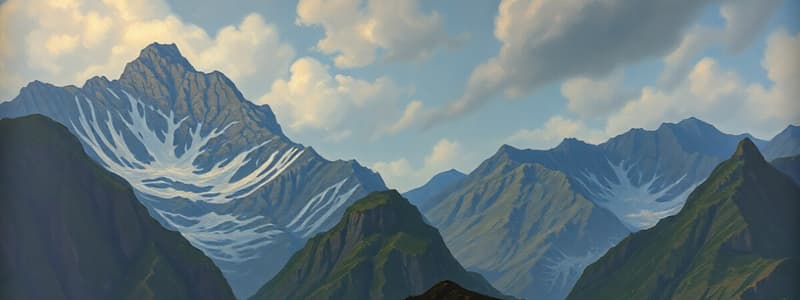Podcast
Questions and Answers
What is the primary process that leads to mountain formation?
What is the primary process that leads to mountain formation?
- Orogenesis (correct)
- Volcanic activity
- Erosion of the Earth's crust
- Plate tectonics
Which best describes the relationship between continental drift and plate tectonics?
Which best describes the relationship between continental drift and plate tectonics?
- Continental drift is a more recent theory compared to plate tectonics.
- There is no relationship between continental drift and plate tectonics.
- Plate tectonics completely replaced the theory of continental drift.
- Continental drift provided observations that supported plate tectonics. (correct)
How does the geological time scale aid in understanding Earth's history?
How does the geological time scale aid in understanding Earth's history?
- It provides general information on climate changes.
- It gives a comprehensive framework for the sequence and timing of events. (correct)
- It shows the distribution of resources over time.
- It focuses solely on the formation of mountains.
At which type of plate boundary does orogenesis primarily occur?
At which type of plate boundary does orogenesis primarily occur?
What impact do geotectonic processes have on the Earth's resources?
What impact do geotectonic processes have on the Earth's resources?
What is the primary driving force behind plate tectonics?
What is the primary driving force behind plate tectonics?
What geological phenomenon is primarily associated with divergent boundaries?
What geological phenomenon is primarily associated with divergent boundaries?
Which of the following scales is used to measure the intensity of earthquakes?
Which of the following scales is used to measure the intensity of earthquakes?
What is a common result of convergent boundaries?
What is a common result of convergent boundaries?
How do earthquakes originate?
How do earthquakes originate?
What characterizes transform boundaries?
What characterizes transform boundaries?
Which factor does not influence volcanic eruption types?
Which factor does not influence volcanic eruption types?
What is the role of magma in volcano formation?
What is the role of magma in volcano formation?
Flashcards
Continental Drift
Continental Drift
The theory that continents have moved across the Earth's surface.
Orogenesis
Orogenesis
Process of mountain formation, involving the deformation and uplift of Earth's crust.
Geological Time Scale
Geological Time Scale
A framework for understanding the timeline of Earth's history, divided into eons, eras, periods, epochs.
Convergent Plate Boundary
Convergent Plate Boundary
Signup and view all the flashcards
Geotectonics
Geotectonics
Signup and view all the flashcards
What is geotectonics?
What is geotectonics?
Signup and view all the flashcards
What is plate tectonics?
What is plate tectonics?
Signup and view all the flashcards
What are divergent boundaries?
What are divergent boundaries?
Signup and view all the flashcards
What are convergent boundaries?
What are convergent boundaries?
Signup and view all the flashcards
What are transform boundaries?
What are transform boundaries?
Signup and view all the flashcards
What is mantle convection?
What is mantle convection?
Signup and view all the flashcards
What causes earthquakes?
What causes earthquakes?
Signup and view all the flashcards
How are volcanoes formed?
How are volcanoes formed?
Signup and view all the flashcards
Study Notes
Introduction to Geotectonics
- Geotectonics studies large-scale Earth processes shaping the surface and interior.
- It examines plate movement, mountain building, earthquakes, volcanoes, and geological formations.
- It draws on structural geology, petrology, and seismology principles.
Plate Tectonics
- Plate tectonics is a core concept in geotectonics.
- The Earth's lithosphere is divided into rigid plates.
- These plates move due to mantle convection currents.
- Interactions at plate boundaries cause various geological events.
Plate Boundary Types
- Divergent boundaries: Plates separate, creating new crust at mid-ocean ridges via magma upwelling.
- Convergent boundaries: Plates collide, causing subduction (one plate descending) or mountain building (continental collision). Volcanism and earthquakes are common.
- Transform boundaries: Plates slide horizontally past each other, resulting in significant earthquake activity.
Mantle Convection
- The Earth's mantle, a semi-molten rock layer, has convection currents.
- Temperature and density differences drive these currents.
- Mantle convection is the primary driver of plate tectonics.
Earthquake Mechanism
- Earthquakes occur from sudden energy release in rocks along fault lines.
- Released energy creates seismic waves traveling through the Earth.
- Magnitude and intensity are measured by the Richter and Mercalli scales, respectively.
Volcano Formation
- Magma rising from the mantle through weaknesses in the crust forms volcanoes.
- Volcanic activity is often associated with plate boundaries.
- Magma composition and environment impact volcanic eruption types.
Continental Drift
- Continental drift, a prior theory, proposed continent movement.
- It preceded plate tectonics, but observations influenced its development.
- Geophysics and ocean floor studies provided support for plate tectonics.
Mountain Building (Orogenesis)
- Orogenesis is the formation of mountains.
- It involves deformation and uplift of Earth's crust.
- Orogenesis occurs most often at convergent boundaries, particularly continental collisions, leading to crustal crumpling and faulting.
Geological Time Scale
- The geological time scale organizes Earth's history.
- It's structured in eons, eras, periods, epochs, and ages.
- Geotectonic processes change across these time periods. These changes impact continents, oceans, climate, and life evolution
Other Important Considerations
- Geotectonics significantly affects resource distribution (minerals, fossil fuels).
- Studying geotectonics helps understand and mitigate natural disaster risks (earthquakes, volcanoes).
- The dynamic Earth's geosphere continually shapes landscapes through formation, erosion, and alteration.
Studying That Suits You
Use AI to generate personalized quizzes and flashcards to suit your learning preferences.



